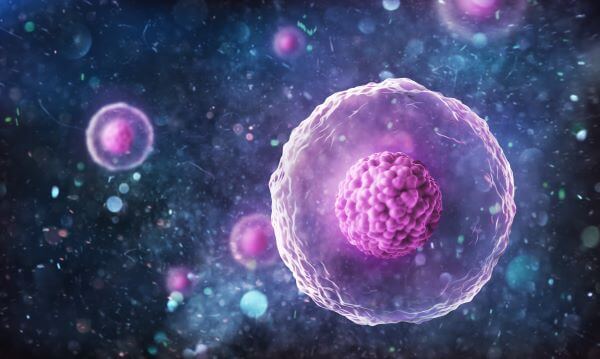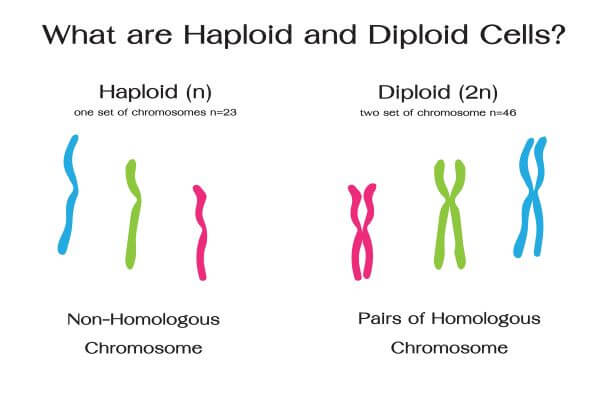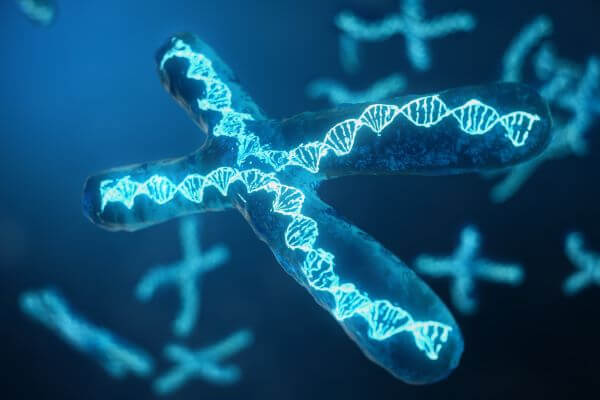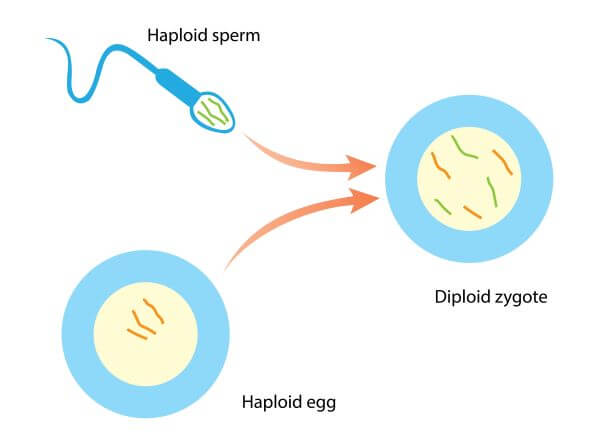A diploid cell contains two complete sets of chromosomes in its nucleus, whereas haploid cells only contain a single copy. Most human body cells are diploid, and only the gametes (sperm and egg cells) are haploid.
Chromosomes in diploid cells are arranged in homologous pairs. The diploid chromosome number of a cell (2n) is the total number of chromosomes in a cell. In the case of humans, 2n = 46, meaning there are a total of 46 chromosomes in a diploid human cell.

What is a Diploid Cell?
A diploid cell is a cell that contains a complete set of chromosomes in its nucleus. Each chromosome in a diploid cell has two copies, which are arranged in homologous pairs. These homologous pairs are not identical, but they do ‘match,’ meaning the chromosomes have the same genes in the same loci and are the same size and shape as one another.
Homologous chromosome pairs contain DNA from both parents of the organism; one chromosome from each pair is donated by the father, and the other by the mother.

How Many Chromosomes Are in a Human Diploid Cell?
The diploid chromosome number (usually represented as 2n) is the number of chromosomes in a diploid cell’s nucleus. Human diploid cells contain 23 homologous chromosome pairs, making a total of 46 chromosomes. Therefore, the diploid chromosome number of human cells is 2n = 46.
Two of the chromosomes found in human cells are sex chromosomes, which determine the sex of the organism. Females have two X chromosomes (XX), whereas males have one X and one Y chromosome (XY). This is the only instance in which a homologous pair does not contain two copies of the same chromosome.
The 2n number of diploid cells varies significantly between organisms, as different species have different numbers of chromosomes. For example, the diploid number of garlic is 2n = 16, in dogs, it’s 2n = 28, and in elephants, the diploid number is 2n = 56.

Examples of Diploid Cells
All body (AKA somatic) cells are diploid. Therefore, the vast majority of cells in the human body are diploid and contain a full set of chromosomes. Examples of diploid cells in humans include:
- Muscle cells
- Skin cells
- Blood cells
- Nerve cells
- Bone cells
The only human cells that are haploid (i.e., containing a single set of chromosomes) are the gametes, or sex cells. In humans, the haploid chromosome number is n = 23.
During sexual reproduction, the haploid sperm and egg cells fuse to make a single diploid cell (also called a zygote). The diploid zygote will contain genetic information from both of the parental sex cells; 50% from the egg cell, and 50% from the sperm cell.

Diploid Cell Reproduction
Diploid cells reproduce via mitosis. During mitosis, the diploid parent cell replicates all of its DNA, creating a new set of chromosomes that are identical to the originals. As the cell divides, it donates a full set of DNA to the new daughter cell and, in doing so, creates a genetically identical copy of itself.

The Diploid Life Cycle
Organisms that reproduce sexually (like humans) have a diploid-dominant life cycle and spend most of their lives as diploid adults. Almost all of their cells are diploid, the only exception being the haploid gametes. When they reach sexual maturity, diploid organisms will produce haploid sex cells using meiosis, a type of cell division that produces four non-identical cells. These non-identical daughter cells each contain half the number of chromosomes as the original cell.
When fertilization occurs, two haploid gametes fuse to create a diploid zygote. The zygote then divides via mitosis, producing two identical daughter cells. Through repeated rounds of cell division, the zygote eventually develops into a diploid adult, and the cycle continues.

Diploid Cells vs. Haploid Cells
The key differences between haploid and diploid cells are summarized in the table below.
Diploid Cells |
Haploid Cells |
|
| Chromosome Number | Contain two sets of chromosomes (2n) | Contain a single set of chromosomes (n) |
| Reproduction | Reproduce by mitosis | Reproduce by meiosis |
| Examples | Somatic (body) cells, e.g., skin cells, nerve cells, muscle cells, etc. | Gametes, e.g., sperm and egg cells |
